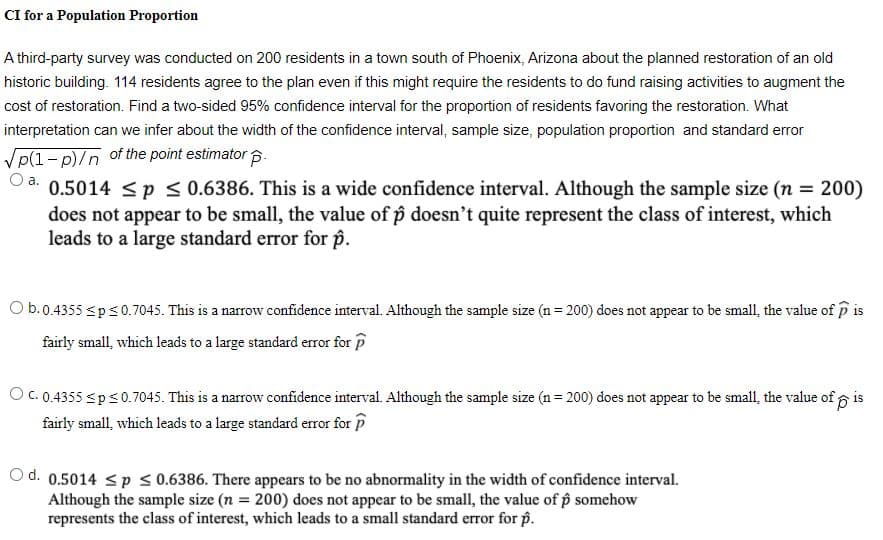A third-party survey was conducted on 200 residents in a town south of Phoenix, Arizona about the planned restoration of an old historic building. 114 residents agree to the plan even if this might require the residents to do fund raising activities to augment the cost of restoration. Find a two-sided 95% confidence interval for the proportion of residents favoring the restoration. What interpretation can we infer about the width of the confidence interval, sample size, population proportion and standard error p(1- p)/n of the point estimator s.
A third-party survey was conducted on 200 residents in a town south of Phoenix, Arizona about the planned restoration of an old historic building. 114 residents agree to the plan even if this might require the residents to do fund raising activities to augment the cost of restoration. Find a two-sided 95% confidence interval for the proportion of residents favoring the restoration. What interpretation can we infer about the width of the confidence interval, sample size, population proportion and standard error p(1- p)/n of the point estimator s.
College Algebra (MindTap Course List)
12th Edition
ISBN:9781305652231
Author:R. David Gustafson, Jeff Hughes
Publisher:R. David Gustafson, Jeff Hughes
Chapter8: Sequences, Series, And Probability
Section8.7: Probability
Problem 58E: What is meant by the sample space of an experiment?
Related questions
Question
please answer urgent

Transcribed Image Text:CI for a Population Proportion
A third-party survey was conducted on 200 residents in a town south of Phoenix, Arizona about the planned restoration of an old
historic building. 114 residents agree to the plan even if this might require the residents to do fund raising activities to augment the
cost of restoration. Find a two-sided 95% confidence interval for the proportion of residents favoring the restoration. What
interpretation can we infer about the width of the confidence interval, sample size, population proportion and standard error
Vp(1- p)/n of the point estimator p.
0.5014 <p < 0.6386. This is a wide confidence interval. Although the sample size (n = 200)
does not appear to be small, the value of p doesn't quite represent the class of interest, which
leads to a large standard error for p.
Oa.
Ob.0.4355 sps0.7045. This is a narrow confidence interval. Although the sample size (n = 200) does not appear to be small, the value of p is
fairly small, which leads to a large standard error for p
O C. 0.4355 sps0.7045. This is a narrow confidence interval. Although the sample size (n = 200) does not appear to be small, the value of p is
fairly small, which leads to a large standard error for P
O d. 0.5014 < p s0.6386. There appears to be no abnormality in the width of confidence interval.
Although the sample size (n = 200) does not appear to be small, the value of p somehow
represents the class of interest, which leads to a small standard error for p.
Expert Solution
This question has been solved!
Explore an expertly crafted, step-by-step solution for a thorough understanding of key concepts.
Step by step
Solved in 2 steps

Recommended textbooks for you

College Algebra (MindTap Course List)
Algebra
ISBN:
9781305652231
Author:
R. David Gustafson, Jeff Hughes
Publisher:
Cengage Learning

College Algebra (MindTap Course List)
Algebra
ISBN:
9781305652231
Author:
R. David Gustafson, Jeff Hughes
Publisher:
Cengage Learning